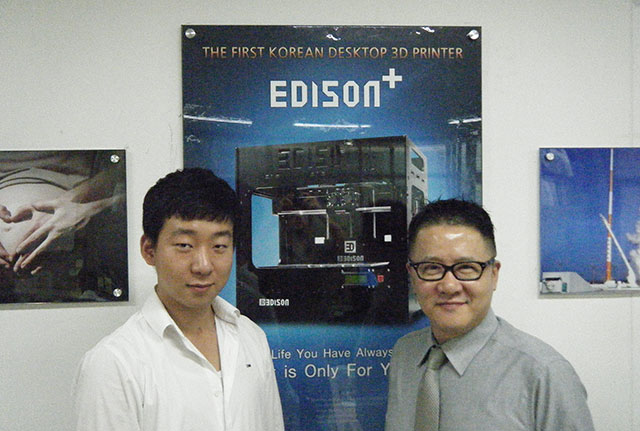South Korea is today one of the most technologically advanced and technologically-obsessed cultures in the world, so it is fairly surprising that 3D printing is relatively rare here. While there have been a few television news stories, and a few printed articles, there has not been much excitement about the technology. But there is hope, for in this vacuum a small innovative, and surprisingly energetic start-up has emerged.
Rokit (pronounced “rocket”) introduced its first consumer-level 3D printer called the “Edison” earlier this year. With only 25 employees, Rockit designs, builds and tests its printers on-site at its facility in Seoul. To date the company has filed for 19 patents, and has sold about 500 machines, mostly in Korea. But that could change quickly as the team is looking to expand globally. Currently they are building their machines to order, so there is a slight lag time between the order and the shipment, but the company founder and CEO, Seok Hwan Yoo said that he expects that lag to shrink as sales increase.

While bearing more than a passing resemblance to the MakerBot Replicator 2, Rokit’s new machine has some significantly different features and capabilities, which I was lucky enough to see this past week. The Edison, like the MakerBot, is designed to operate with PLA filament and can be purchased in single or dual extruder formats. Scott Yoo, the company’s chief marketing officer, demonstrated that while the printer’s display shows most of the usual information that one would expect, it has a few differences. One of my favorites was that it could show you where the machine’s current z-axis position is at any given time (in millimeters) and how much filament you used making a print (in meters). It also allows the user to change the print speed and print temperature on the fly and has the ability to print at the 50 micron level. Scott advised me that while this capability is impressive, to print at such a fine level does take some careful calibration on the part of the operator. Still, the fact that it is possible for the machine to print at such a high resolution was impressive as this is twice the resolution of almost all other consumer grade FFF (fused filament fabrication) printers. He noted however, that most routine printing is done on the Edison at the 150 micron level, and that it runs very smoothly at that resolution. For comparison, the default resolution for most printers is typically between 200 and 300 microns, though finer settings are possible on many models.
Scott took the time to show me that, like MakerBot with its “MakerWare” slicer program, the Edison uses its own slicer program called “Creator K” which he advised is compatible with all popular 3D file formats, and is available in an English-language version. Unfortunately due to time constraints, I was not able to try the software out, but do look forward to using it in the very near future and reporting on my results. Scott also advised that, in a move that struck me as both humorous and serious, they had “torture tested” their machine by placing one in a sauna at 77° C for four hours and then in a freezer at -30° C for half a day. In both cases he said the printer was able to print without any trouble.
But of all the features the Edison offered, none was more welcome than the price. At 1,750,000 Korean Won (don’t panic, that’s about $1,550 USD) the Edison seems to offer a great value for the home user. While comparable with the most popular prosumer/home 3D printers currently available, it seems to have the capabilities and attributes one would expect of a more expensive machine…as well as a few bonuses. Rokit’s English-language website can be found here.


